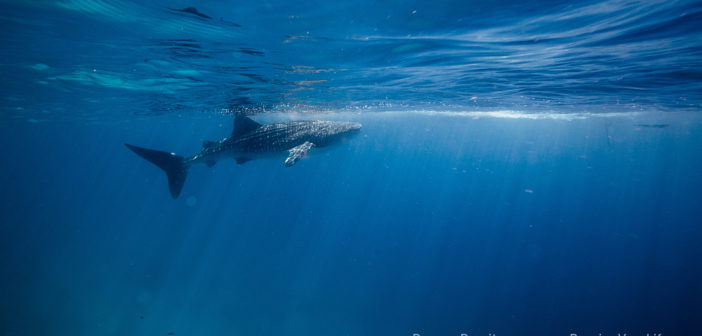They travel the seas in search of feeding grounds, adding more than 25km under their belt every single day. Whalesharks are filtering the water for small nutritional organisms (plankton, krill, jellyfish, small fish, squid, etc.). In order to survive, a juvenile needs to process at least 21kg (46 pounds) of food on a daily basis. They have been called many names: Lord Fish (Cá Ông) in Vietnam, Butanding and Balilan in the Philippines, they even made it to the back of the 100 peso bill. But I prefer “Gentle Giants” for their calm nature and slowly moving huge bodies. Time is passing with a different speed for them. Their hippy nature backed by a school bus size of a body makes the perfect tool to show us the peace that is the main rule in the underwater world.
I can understand people’s thirst to see them, they are a wonder and the encounters are less and less, except, except in a few places where they are being lured into encounters. Somehow they have developed a contract with humans and show up every day at regular times to eat the tiny amounts of food being thrown in the water. Between hundreds of snorkelers and divers they manage with a gentle touch to take what they need and leave behind great memories.

In recent years, life has not been treating them so well. Once they get used to human interaction they tend to swim close to the boats in search for human provided food and often get hurt by the propellers or hull. This leads to them being unable to travel so far and they are forced to stay in the same area. The mating process is not taking place as it normally should for this reason and their numbers are getting smaller and smaller.

Environmentalists fight for protection, fisherman fight for food, governments fight for money. While this fight is taking place, nature is bleeding its richness through its pores. Some of the good news: whalesharks are not being killed and fished anymore like before. People realised that they represent a renewable source of income and, in the long term, it is a benefit to them and their communities to help protect them. This is why I am always torn apart by the decision of wether or not to visit them. On the other hand, between environment, local fisherman and local authorities, steps although being taken tend to happen slowly which is unfortunate. Once the killing has stopped, preservation takes place. The next step will be protection for a longer period of time to allow them to increase their numbers and this is what I am looking forward too the most, to be able to see more of them in their natural habitat.

Tips for a less impact encounter:
– Go snorkeling not diving – less impact.
– Do not use sunscreen lotions. They get in the water, then absorbed by the fish and affect their health.
– Do not touch, chase, harass them.
We humans are wild, unnatural, unadapted and are perhaps guilty of not noticing or abiding by the natural laws of life. They are pure, perfectly adapted, peaceful and still.. on the path to extinction as well as lions, rhinos, elephants, gorillas, tigers, sharks and polar bears, all the things we are stunned by and so lucky to see but that are quickly vanishing. Where is the justice for them? Change must happen if we are to alter their fate.

Photo shooting tips:
– Chasing is useless. Just like the ant chasing the elephant. Find yourself a station point in their way and let them swim towards you.
– Shoot with the light on your back unless you want to shoot some silhouettes and then you need to get the subject between you and the sun.
– Their unique pattern makes a great subject so get some close ups.
– Use their reflection in the waters surface.
– Think about composition and a size reference (diver, corals, boat, other fish) to emphasize their gigantic bodies.
– Shoot using natural light with a custom white balance.
It is important to help understand these creatures before you can understand why it is so important to help save them and that does not give us so much time so join the fight to protect them and indulge in their great wonder and beauty.





